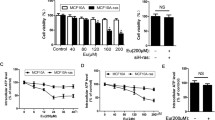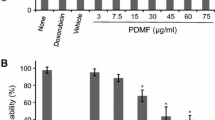Abstract
Kumquats are small citrus fruits produced by the Fortunella japonica tree. In addition to its aroma, kumquat essential oil may have antiproliferative effects; however, research on the effects of kumquat essential oil on human cell lines is limited. This study investigated the effects of kumquat essential oil on the proliferation of three human cell lines (HT-1080 fibrosarcoma cells, HeLa cervical adenocarcinoma cells, and CUA-4 normal human fibroblasts). As the concentration of kumquat essential oil increased, cell proliferation and viability, as measured by MTT activity assays, decreased in all three cell lines. Compared to untreated cells, HT-1080 fibrosarcoma cells exposed to kumquat essential oil exhibited an increased presence of phosphorylated JNK. Apoptosis was also stimulated, as PARP cleavage of treated HT-1080 fibrosarcoma cells was detected. Use of a JNK inhibitor resulted in decreased PARP cleavage in HT-1080 cells following treatment with kumquat EO, suggesting that activity of JNK is implicated in the stress response. The kumquat essential oil constituents limonene and myrcene both independently led to decreased proliferation and apoptosis.







Similar content being viewed by others
Data availability
The datasets generated during and/or analyzed during the current study are available from the corresponding author on reasonable request.
Code availability
Not applicable.
References
Dhifi W, Bellili S, Jazi S, Bahloul N, Mnif W (2016) Essential oils’ chemical characterization and investigation of some biological activities: a critical review. Medicines 3:25. https://doi.org/10.3390/medicines3040025
Lawless J (1995) The illustrated encyclopedia of essential oils: the complete guide to the use of oils in aromatherapy and herbalism. Element Books Limited, New York
Elshafie HS, Camele I (2017) An overview of the biological effects of some Mediterranean essential oils on human health. Biomed Res Int 2017:9268468. https://doi.org/10.1155/2017/9268468
Cieslak E, Mack JP, Rojtman A (2016) Essential oils and methylglyoxal: a possible alternative treatment for antibiotic resistant bacterial infections. Int J Pharm Pharm Sci 8:107–110
Grullon J, Mack JP, Rojtman A (2016) Using essential oils to combat the threat of multi-drug resistant bacteria, Pseudomonas aeruginosa. Int J Pharm Pharm Sci 8:180–183
Wang YW, Zeng WC, Xu PY, Lan YJ, Zhu RX, Zhong K, Huang YN, Gao H (2012) Chemical composition and antimicrobial activity of the essential oil of kumquat (Fortunella crassifolia Swingle) peel. Int J Mol Sci 13:3382–3393. https://doi.org/10.3390/ijms13033382
Abu-gabal NS, Abd-alla HI, Mohamed NZ, Aly HF, Shalaby NMM (2015) Phytophenolics composition hypolipidemic, hypoglycemic and antioxidative effects of the leaves of Fortunella japonica (Thunb.) Swingle. Int J Pharm Pharm Sci 7:55–63
Nazzaro F, Fratianni F, De Martino L, Coppola R, De Feo V (2013) Effect of essential oils on pathogenic bacteria. Pharmaceuticals (Basel) 6:1451–1474. https://doi.org/10.3390/ph6121451
Russo R, Corasaniti MT, Bagetta G, Morrone LG (2015) Exploitation of cytotoxicity of some essential oils for translation in cancer therapy. Evid Based Complement Alternat Med 2015:397821
Trang DT, Hoang T, Nguyen T, Van Cuong P, Dang NH, Dang HD, Nguyen Quang T, Dat NT (2020) Essential oils of lemongrass (Cymbopogon citratus Stapf) induces apoptosis and cell cycle arrest in A549 Lung cancer cells. BioMed Res Int. https://doi.org/10.1155/2020/5924856
Wayne J, Sielski J, Rizvi A, Georges K, Hutter D (2006) ERK regulation upon contact inhibition in fibroblasts. Mol Cell Biochem 286:181–189
Gautam N, Mantha AK, Mittal S (2014) Essential oils and their constituents as anticancer agents: a mechanistic view. BioMed Res Int 2014:154106. https://doi.org/10.1155/2014/154106
Tolosa L, Donato MT, Gómez-Lechón MJ (2015) General Cytotoxicity Assessment by Means of the MTT Assay. In: Vinken M, Rogiers V (eds) Protocols in in vitro hepatocyte research. Methods in molecular biology (methods and protocols), vol 1250. Humana Press, New York
Gaballah M, Slisz M, Hutter-Lobo D (2012) Role of JNK-1 regulation in the protection of contact-inhibited fibroblasts from oxidative stress. Mol Cell Biochem 359:105–113. https://doi.org/10.1016/j.fct.2013.03.017
Davis RJ (2000) Signal transduction by the JNK group of MAP kinases. In: Letts LG, Morgan DW (eds) Inflammatory processes. Progress in inflammation research. Birkhäuser, Basel, pp 13–21
Shaulian E, Karin M (2001) AP-1 in cell proliferation and survival. Oncogene 20:2390–2400. https://doi.org/10.1038/sj.onc.1204383
Kim KN, Ko YJ, Yang HM, Ham YM, Roh SW, Jeon YJ, Ahn G, Kang M-C, Yoon W-J, Kim D, Oda T (2013) Anti-inflammatory effect of essential oil and its constituents from fingered citron (Citrus medica L. var. sarcodactylis) through blocking JNK, ERK and NF-κB signaling pathways in LPS-activated RAW 264.7 cells. Food Chem Toxicol 57:126–131. https://doi.org/10.1016/j.fct.2013.03.017
Wei J, Zhang X, Bi Y, Maio R, Zhang Z, Su H (2015) Anti-inflammatory effects of cumin essential oil by blocking JNK, ERK, and NF-κB signaling pathways in LPS-stimulated RAW2647 cells. J Evid Based Complement Altern Med 2015:474509. https://doi.org/10.1155/2105/474509
Lei K, Davis RJ (2003) JNK phosphorylation of Bim-related members of the Bcl2 family induces Bax-dependent apoptosis. Proc Natl Acad Sci USA 100:2432–2437. https://doi.org/10.1073/pnas.0438011100
Dhanasekaran DN, Reddy EP (2017) JNK-signaling: a multiplexing hub in programmed cell death. Genes Cancer 8:682–694
Lazebnik YA, Kaufmann SH, Desnoyers S, Poirier GG, Earnshaw WC (1994) Cleavage of poly(ADP-ribose) polymerase by a proteinase with properties like ICE. Nature 371:346–347. https://doi.org/10.1038/371346a0
Russo A, Cardile V, Graziano A, Avola R, Bruno M, Rigano D (2018) Involvement of Bax and Bcl-2 in induction of apoptosis by essential oils of three Lebanese salvia species in human prostate cancer cells. Int J Mol Sci 19:292. https://doi.org/10.3390/ijms19010292
Ren P, Ren X, Cheng L, Xu L (2018) Frankincense, pine needle and geranium essential oils suppress tumor progression through the regulation of the AMPK/mTOR pathway in breast cancer. Oncol Rep 39:129–137. https://doi.org/10.3892/or.2017.6067
Jayaprakasha GK, Murthy KNC, Etlinger M, Mantur SM, Patil BS (2012) Radical scavenging capacities and inhibition of human prostate (LNCaP) cell proliferation by Fortunella margarita. Food Chem 131:184–191. https://doi.org/10.1016/j.foodchem.2011.08.058
Jayaprakasha GK, Murthy KNC, Demarais R, Patil BS (2012) Inhibition of Prostate cancer (LNCaP) cell proliferation by volatile components from Nagami kumquats. Planta Med 78:974–980. https://doi.org/10.1055/s-0031-1298619
Choi HS (2005) Characteristic odor components of kumquat (Fortunella japonica swingle) peel oil. J Agric Food Chem 53:1642–1647. https://doi.org/10.1021/jf040324x
Eades J, Hartsel JA, Hickory B, Makriyannis A (2016) Chapter 53: Cannabis sativa and hemp. In: Gupta RC (ed) Nutraceuticals: efficacy, safety, and toxicity. Academic Press, Waltham, MA, pp 735–754
Ferraz RPC, Bomfim DS, Carvalho NC, Soares MVP, Costa EC, Da Silva TB, Machado WJ, Prata APN, Costa EV, Moraes VRS, Nogueira PCL, Bezerra DP (2013) Cytotoxic effect of leaf essential oil of Lippia gracilis Schauer (Verbenaceae). Phytomedicine 20:615–621. https://doi.org/10.1016/j.phymed.2013.01.015
Kim JH, Jung CH, Jang BH, Go HY, Park JH, Choi YK, Hong SI, Shin YC, Ko SG (2009) Selective cytotoxic effects on human cancer cell lines of phenolic-rich ethyl-acetate fraction from Rhus verniciflua Stokes. Am J Chin Med 37:609–620. https://doi.org/10.1142/S0192415X09007090
Badger TM, Fang N, He L, Li Q, Ronis MJJ, Yu S, Zhang J (2006) Inhibition of growth and induction of apoptosis in human cancer cell lines by an ethyl acetate fraction from shiitake mushrooms. J Alternat Complement Med 12:125–132. https://doi.org/10.1089/acm.2006.12.125
Jia S-S, Xi G-P, Zhang M, Chen Y, Lei B, Dong X, Yang Y-M (2013) Induction of apoptosis by D-limonene is mediated by inactivation of Akt in LS174T human colon cancer cells. Oncol Rep 29:349–354. https://doi.org/10.3892/or.2012.2093
Sun J (2007) D-limonene: safety and clinical applications. Altern Med Rev 12:259–264
Miller JA, Lang JE, Ley M, Nagle R, Hsu CH, Thompson PA, Cordova C, Waer A, Sherry Chow HH (2013) Human breast tissue disposition and bioactivity of limonene in women with early stage breast cancer. Cancer Pre Res 6:577–584. https://doi.org/10.1158/1940-6207.CAPR-12-0452
Yu X, Lin H, Wang Y, Lv W, Zhang S, Qian Y, Deng X, Feng N, Yu H, Qian B (2018) D-limonene exhibits antitumor activity by inducing autophagy and apoptosis in lung cancer. Onco Targets Ther 11:1833–1847. https://doi.org/10.2147/OTT.S155716
Surendran S, Qassadi F, Surendran G, Lilley D, Heinrich M (2021) Myrciene—what are the potential health benefits of this flavouring and aroma agent? Front Nutr 8:6996666. https://doi.org/10.3389/fnut2021.699666
Bai X, Tang J (2020) Myrcene exhibits antitumor activity against lung cancer cells by inducing oxidative stress and apoptosis mechanisms. Nat Prod Comm 15:1–7. https://doi.org/10.1177/1934578X20961189
Acknowledgements
The authors wish to thank Drs. Ellen Doss-Pepe, Yusen Liu, and Maurice Lobo for helpful discussion. We are grateful for the support of Mr. Kevin Young for the School of Science Summer Research Program and for helpful discussion.
Funding
Not applicable.
Author information
Authors and Affiliations
Corresponding author
Ethics declarations
Conflict of interest
Not applicable.
Additional information
Publisher's Note
Springer Nature remains neutral with regard to jurisdictional claims in published maps and institutional affiliations.
Rights and permissions
About this article
Cite this article
Soni, S., Parekh, M.Y., Jacob, J.A. et al. Kumquat essential oil decreases proliferation and activates JNK signaling and apoptosis in HT-1080 fibrosarcoma cells. Mol Cell Biochem 477, 445–453 (2022). https://doi.org/10.1007/s11010-021-04291-2
Received:
Accepted:
Published:
Issue Date:
DOI: https://doi.org/10.1007/s11010-021-04291-2




